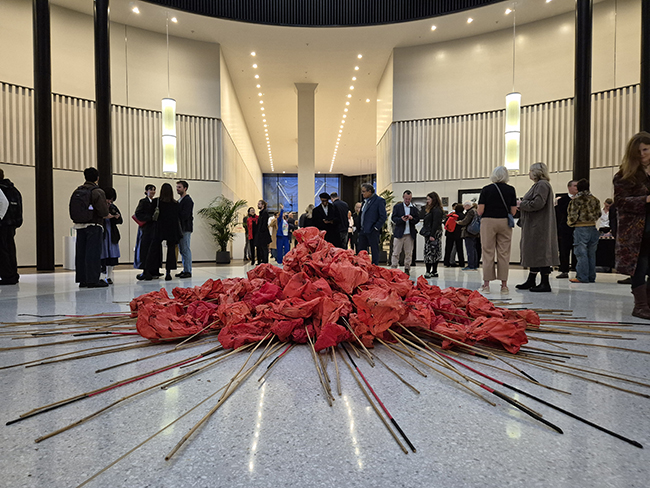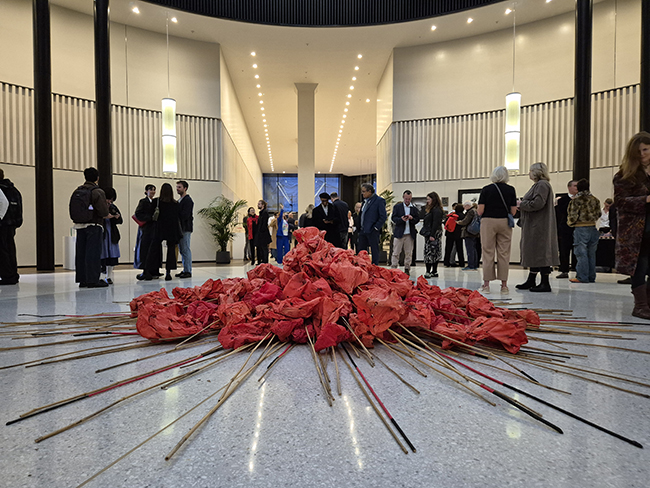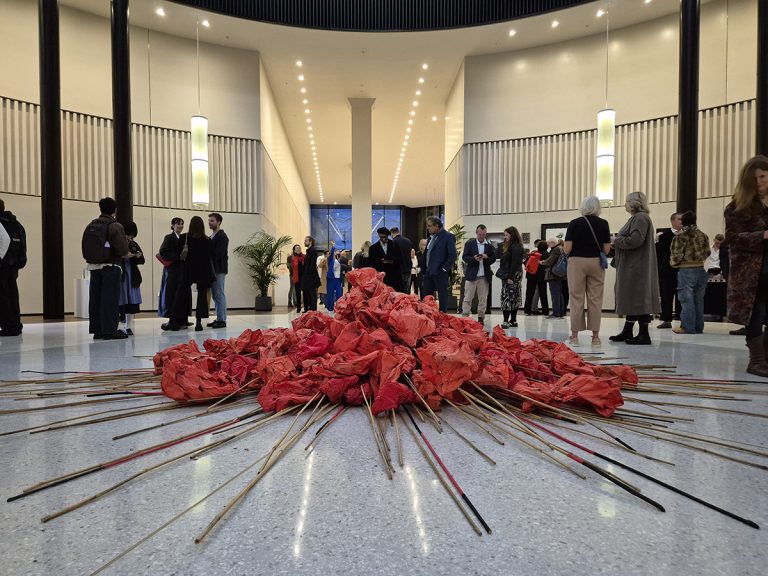Bea Last, a Scottish artist working from the rugged beauty of her homeland, creates art that lives between sculpture and drawing. Her practice transforms the overlooked—recycled, repurposed, salvaged, or gifted materials—into what she calls sculptural drawing. In her hands, the discarded becomes eloquent, reshaped into forms that carry both fragility and force. Her art is a conversation about how we survive and rebuild in the face of destruction. Through abstraction and process, Last explores conflict, displacement, climate anxiety, and the quiet persistence of hope. Her work doesn’t seek to soothe—it awakens. It asks viewers to sit with discomfort and to see beauty not as perfection, but as endurance.
Images of The Red Bags – Sculptural Drawings Installation

At first encounter, Images of The Red Bags feels deceptively simple—a gathering of red forms. Yet the longer you stand with it, the more it reveals. Created from 700 hand-formed bags using bamboo, recycled fabric, and materials marked with bullet holes, the installation carries both physical and emotional weight. It was presented at VAO 2025 (Visual Arts Open) Finalist Exhibition at The Minster, Mincing Lane in London, where it occupied the space like a living organism—growing, breathing, remembering.
Each bag feels personal, but together they form a collective. They hang in clusters, echoing human migration, memory, or loss. Red dominates the installation, not as decoration but as a statement. It is the color of life and of warning, of wound and survival. In this field of red, contradictions meet: beauty and pain, renewal and destruction.

Some bags are pierced by bullet holes—real marks of violence embedded in the material. Others seem to heal themselves through form, their folds and knots suggesting recovery. Last’s choice to incorporate damage into the work transforms injury into testimony. Nothing is hidden or disguised; instead, it’s absorbed into the narrative.
The process behind The Red Bags is as meaningful as the final piece. Last collects what has been thrown away—bamboo sticks, torn fabric, fragments of the everyday world. She gives them a second life through repetition, touch, and time. The act of making becomes ritualistic, each bag a small meditation on repair. Her materials aren’t just tools; they are collaborators, holding traces of other lives and histories.
Inside the gallery, the installation occupies air rather than wall. It’s immersive, almost atmospheric. Visitors walk through and around it, shifting between density and emptiness. There’s no clear beginning or end, only movement—like breathing. The piece hums with quiet energy, as if holding a thousand unspoken stories. It’s both sculpture and memory suspended in motion.
The title, Images of The Red Bags, carries layers of meaning. Each bag stands as an image—an object that holds more than it shows. Together, they become a visual archive of trauma and resilience. They might recall refugee bundles, medical pouches, or ritual offerings. It’s impossible not to imagine the unseen weight they carry—the ghosts of conflict, the ache of displacement, or the tenderness of repair.
What makes this work resonate is its dual perspective. It speaks to the world’s ongoing crises—war, migration, the collapse of balance between humans and nature—yet it’s also an intimate portrait of the artist’s own persistence. Through her practice, Last turns making into an act of empathy. The repetition of form becomes a rhythm of endurance, a quiet defiance against loss.
Standing before The Red Bags, there’s a stillness that feels sacred. You sense the time embedded in every knot and fold, the patience of hands working through grief. It’s not art that demands attention, but one that rewards presence. The bullet holes aren’t shocking—they’re reminders that damage can coexist with beauty, that healing doesn’t erase scars but gives them meaning.
Bea Last’s sculptural drawings do not rest on spectacle. They stand as evidence of care, labor, and consciousness. They show that repair is not about perfection—it’s about attention. In Images of The Red Bags, art becomes both a memorial and a gesture of hope. It offers no answers, only space to feel, to remember, and to see that even in ruin, there is the possibility of renewal—one red bag at a time.

